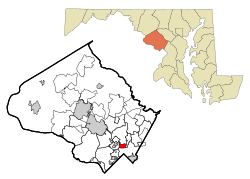Forest Glen, Maryland facts for kids
Quick facts for kids
Forest Glen, Maryland
|
|
|---|---|

Location of Forest Glen, Maryland
|
|
| Country | |
| State | |
| County | Montgomery |
| Area | |
| • Total | 1.00 sq mi (2.60 km2) |
| • Land | 1.00 sq mi (2.60 km2) |
| • Water | 0.00 sq mi (0.01 km2) |
| Elevation | 371 ft (113 m) |
| Population
(2020)
|
|
| • Total | 6,897 |
| • Density | 6,876.37/sq mi (2,655.36/km2) |
| Time zone | UTC−5 (Eastern (EST)) |
| • Summer (DST) | UTC−4 (EDT) |
| FIPS code | 24-28640 |
| GNIS feature ID | 2389096 |
Forest Glen is a community in Montgomery County, Maryland, United States. It's known as a census-designated place (CDP). This means it's an area that the government counts for population, but it's not officially a city or town with its own local government. In 2020, about 6,897 people lived there.
Contents
Where is Forest Glen?
Forest Glen is located in Maryland, just north of Silver Spring. It's also found north of the Capital Beltway, which is a big highway that circles around Washington, D.C..
The United States Census Bureau says that Forest Glen covers about 1.3 square miles (3.4 square kilometers) of land. Even though it's mostly land, you can find Sligo Creek and some small ponds in the area.
How Many People Live in Forest Glen?
| Historical population | |||
|---|---|---|---|
| Census | Pop. | %± | |
| 2010 | 6,582 | — | |
| 2020 | 6,897 | 4.8% | |
| source: 2010–2020 |
|||
Forest Glen is home to many people from different backgrounds. In 2000, there were 7,344 people living there. By 2020, the population was 6,897. This community has a mix of families and individuals.
Community Life in Forest Glen
Forest Glen offers many fun outdoor spaces. You can visit Rock Creek Park and Sligo Creek Park for walks, bike rides, or just to enjoy nature.
The community is also home to the National Museum of Health and Medicine. This museum has amazing exhibits about how the human body works and the history of medicine. There's also Holy Cross Hospital, a regional hospital that serves the area.
A group called the Friends of Forest Glen works to help and improve the community. Forest Glen also has a special place called the National Park Seminary. It's a unique neighborhood built in an old, historic building complex.
A Look Back: Forest Glen's History
Forest Glen has a long history, dating back to the 1600s.
Early Days and Important People
In 1680, a large piece of land that included Forest Glen was given to an ancestor of John Carroll. John Carroll later became an important leader in the Catholic Church in the United States.
Daniel Carroll, one of the people who helped create the United States, lived in Forest Glen. He was buried in the cemetery of St. John the Evangelist Catholic Church in Forest Glen. The first church building was made of wood in 1774. It was later replaced with a brick building in 1894.
Neighborhoods and Development
In the past, some neighborhoods had rules that were unfair. For example, the Woodside Knolls neighborhood once had rules that tried to stop Black and Jewish people from living there. These kinds of rules are now illegal and not allowed.
The Forest Estates neighborhood in Forest Glen was built in the 1940s. Before that, the area was mostly farmland. Builders like Leo Minskoff and Anthony Campitelli helped create the houses in Forest Estates.
Forest Glen Metro Station
The Forest Glen station is part of the Metrorail system, which is the subway in the Washington D.C. area. When it was first planned, the station was going to be built above ground. This would have meant tearing down many homes. But the community spoke up, and the plan was changed to build the station underground.
The Forest Glen station opened on September 22, 1990. It is about 160 feet (49 meters) below ground, making it the deepest train station in the entire Metrorail system!
Future Plans for Forest Glen
For many years, there have been plans to improve and redevelop parts of Forest Glen. In 2017, local planners started looking at ways to develop the area. In 2018, the company that runs the Metro system, WMATA, even looked into building new things on the 8-acre parking lot of the Forest Glen station.
See also
In Spanish: Forest Glen (Maryland) para niños

